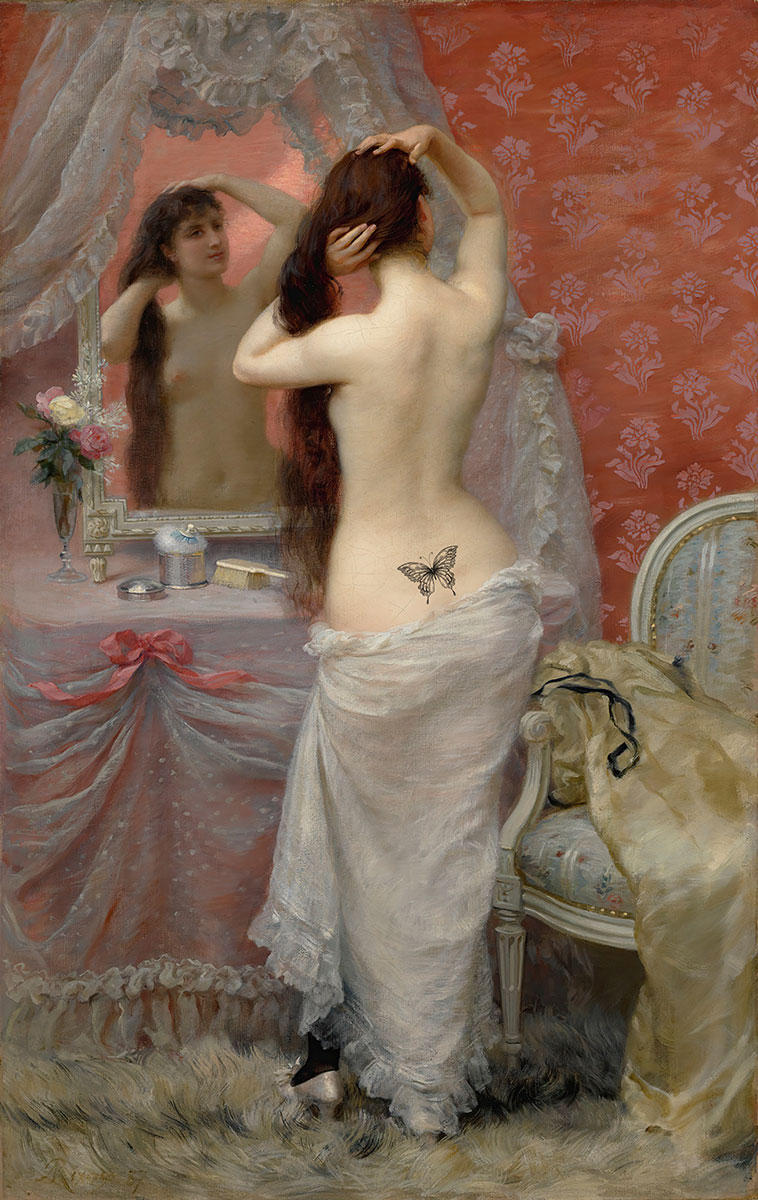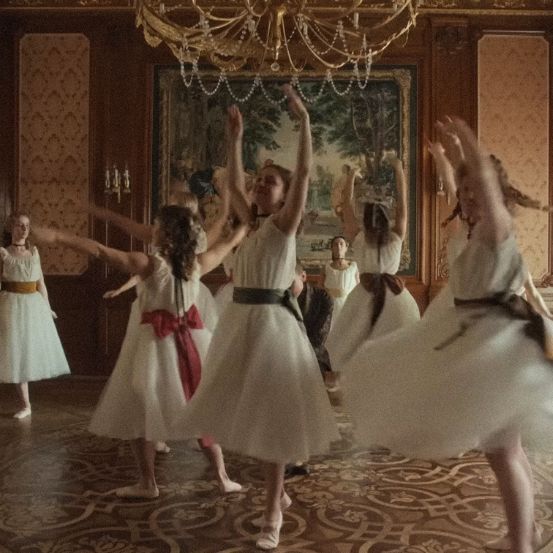Call it queen b(utterfly), for there is no greater queen of controversy than this tattoo. Heir to the low-waisted pants and holder of the treasure of sexuality, the butterfly has called and wants to claim her authority. There is nothing tramp about this stamp.
Call it queen b(utterfly), for there is no greater queen of controversy than this tattoo. Heir to the low-waisted pants and holder of the treasure of sexuality, the butterfly has called and wants to claim her authority. There is nothing tramp about this stamp.

Artwork by Mariana Matos
Artwork by Mariana Matos
How many butterflies does it take for a tattoo to acquire a negative meaning? Only one, if it’s in the right place. A simple stereotypical placement and all the innocence associated with the most beautiful of insects falls away. And this is not only the case with butterflies. We could be talking about a pair of wings, a bed of roses, or a tribal pattern. Any of these symbols takes on a new meaning from the moment it is tattooed on the lower back of a woman. Yes, a woman. Perhaps that is the most important detail of this description, this set of attributes that have given origin not only to a new category of tattoos, but also a way to define the sexual practices of people who identify with the female gender, simply because of the way they choose to present their bodies. The story is nothing new, but this time it has a plot twist.
Tramp stamp. When looking for a literal definition of the term "tramp stamp" we are more of less left without understanding anything about it. In justice of the common online dictionary, this concept needs more than a word-by-word interpretation for it is in its cultural context that its true meaning lies. That is why, in the search for a definition, we turned to the Urban Dictionary and found the following explanation, entered by user Meghan Victoria on June 6, 2005: "a horribly cliche, or common tattoo that makes girls look like dumb bitches. Found on the lower back, and usually a butterfly...sometimes a happy flower of some sort." Although Meghan Victoria (aka Karen) is miles away from what the concept represents, she is still the perfect example of the pejorative force that these two words can aggregate. We therefore turn to Rebeca Verde, an expert in sex-positive communication, to enlighten us as to which criteria defines a tramp stamp. Let's start with the criteria that society associates with this type of tattoo, such as "being in the center of the lower back," as we have already said, "being visible" - it's a Fashion thing, we'll get to that later - and "not being on the back of a cis-man," to which Rebeca adds a sarcastic, yet very necessary, "lol." What follows are the criteria that the expert considers to be contemporary to our understanding of a tramp stamp: "to be sexy" and "to empower," preserving only the placement that was associated with it.
To understand the difference between the various interpretations that originate from this tattoo, it’s important to know the history that exposed them to the eyes of the world. "In the 90s, the tramp stamp was that tattoo that only prostitutes, strippers, or women who worked in bars had, since it was said they got more tips for that," explains Mariza Seita, tattoo artist at Ink&Wheels studio. This connection with the last decade of the previous millennium is also due to the fashion trends that reigned then, namely "the super low-waisted pants," which provided a privileged view of the back area. Because of its positioning, and the professional occupations that popularized it, the tramp stamp gained the popular meaning of "slut tattoo", and it was exactly under this name that Rebeca Verde first heard of it. "I was in the Algarve, at the beach with my mother, (...) we were sitting on the sand and a lady walks in front of us, and she had these dolphins jumping on her back. I was hypnotized. But my mother told me right away that this kind of tattoos was not well-respected, that they were ‘slut tattoos’". And what do we call when these tattoos are seen on men? Actually, this concept only comes in one gender, the feminine. "No, I've never tattooed a tramp stamp on a man, but I think plumbers should have one," shares Mariza Seita between laughs, which in no way diminishes the strength of this statement. In decades of experience, Mariza has never drawn a tattoo on a man's lower back. But she has lost count of the ones she has drawn on women - and the ones she has removed. "A lot of people want to cover them up, they say it doesn't make sense anymore or because they did it when they were very young." Mariza Seita says she has never refused to tattoo a tramp stamp - also because that name is rarely uttered by her clients, who just ask for "a tattoo on the lower back" - but she feels it is her role to question some of the requests that come to her studio. "If they ask me [to tattoo] their husband's name on the lower back, if I have to, I'll stay for two hours - as has happened - talking to the person: 'But are you sure? Let's do something more symbolic, let's not do a name.' It's part of my job."
One can understand the reluctance to tattoo a husband's name (on the lower back or anywhere else, really), however, what harm did butterflies do to be the target of hatred from the likes of Meghan Victoria? Their big, and only, sin is their silhouette, which fits so well on the lower back that it should be a crime. "Any tattoo artist likes to do something that is fluid in that area, just like in any other area of the body. For example, if it's on a leg, I have to make it look anatomically beautiful, and the same thing happens there," Mariza Seita explains. Furthermore, the butterfly seems to be to tattoos what the white t-shirt is to Fashion. When you don't know what to choose, you choose what is safe, what you already know will always look good. And the butterfly represents all that. "It's that thing of being free, the transformation, too. A lot of people identify with that meaning of the butterfly," says the tattoo artist at Ink&Wheels. If the butterfly is synonymous with freedom, why does it continue to bind so many women to antiquated conceptions of gender just because it is placed on the lower back? It was by asking questions like this that many women began to take control of the narrative. "Yes, I have a tramp stamp. It's one of my favorite tattoos, I got it as soon as I finished college and earned my first paycheck," says Rebeca Verde, who showed great enthusiasm from the first moment she was invited to share her story. "I think maybe it was a way to mark myself as a strong, independent and sexually confident woman. Like all my tattoos, the only purpose is to decorate me, my body." Rebeca is not alone, there are several women who decide to get their lower back tattooed, without much justification needed other than the only one that matters: because they want to. "In the last ten years I must have tattooed about five [tramp stamps], but now it's coming back," says Mariza Seita, confirming the trend.
In light of their growing popularity, tramp stamps have been under the watchful eye of several media outlets and were even one of the featured subjects of one of the episodes of The Drew Barrymore Show in 2021. Together with Dakota Johnson, the actress said it was time to find a new name for these tattoos, presenting a few suggestions: "back jazz, tail art, spine design," or, my favorite, "butt crown." These are clearly cleaver designations, which remove the negative value once associated with the tattoos, but to what extent will erasing the term "tramp stamp" from history have a positive result? In the words of Rebeca Verde, "I don't think we can cut ties with the term, which is almost a reminder of the slut-shamer culture that surrounds us. Instead, I think it's even productive to approach the topic seriously and tattooing and 'rocking' that tattoo with the dignity it deserves, reclaiming the right we have to be sexy, to express our sensuality and sexuality confidently and safely." Mariza Seita agrees and believes that the onus of choice should fall on those who wear said tattoo: "If I want to proudly say 'I have a tramp stamp', I can do it and that's not why it's bad or wrong." Furthermore, the tattoo artist explains how this is actually an unusual case, where a tattoo is defined by its placement on the body. "There are names for tattoo styles, but there are no names for tattoo places. If I want to get a tattoo in the middle of my eyebrows, I'm not going to say 'I want a Frida [Kahlo] tattoo.' It doesn't make sense."
Whether you choose to keep the name that brought it into the world or find a new one that defines its meaning in the 21st century, it is, above all, important to rethink what tramp stamps represent today. More than just a tattoo on the lower back, they are as much a symbol of the evolution of women's rights since the 90s as they are of the path yet to be walked. "For me, despite being born from a place of hatred for people who identify with the female gender (especially sex workers), this concept should not be said softly or taken as a placement to avoid, it even deserves our pride. After all, it's about celebrating the right and freedom we have over our bodies and our choices," says Rebeca Verde. Today, the sex-positive communication expert recognizes that even the most progressive minds can fall into the risk of perpetuating the misogyny we've been taught. "For example, when my mother told me that [the tramp stamp] was a ‘slut tattoo,’ she was putting limits on our bodies. Even if in an unconscious way, and coming from a protective place, I wonder if she wasn't exactly passing on to me that misogyny she was trying to keep me away from." Already being, per se, synonymous with freedom, perhaps it's time to make the butterfly a symbol of liberation. Fly, butterfly, fly, and don't return until you can land on a woman's back without her being judged for her choices.
Translated from the original on The Butterfly Effect issue from Vogue Portugal, published October 2022.Full story and credits on the print issue.
Most popular

Relacionados
.jpg)






.png)